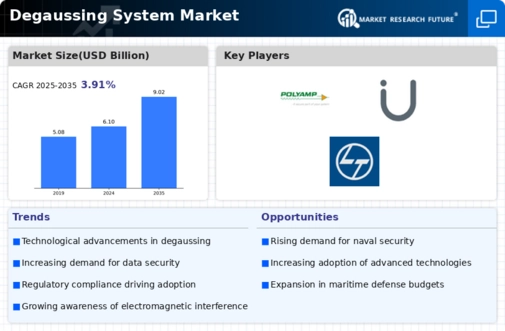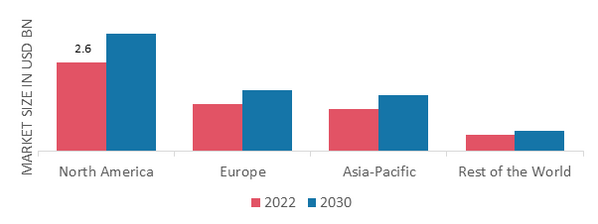Market Analysis
Degaussing System (Global, 2023)
Introduction
The Degaussing System market is characterized by its critical role in the protection and maintenance of naval vessels, as well as various industrial applications where magnetic interference can pose significant risks. As technological advancements continue to evolve, the demand for sophisticated degaussing solutions has surged, driven by the need for enhanced security measures and operational efficiency. This market encompasses a diverse range of products and services designed to mitigate the effects of magnetic fields, ensuring the integrity of sensitive equipment and the safety of personnel. With increasing awareness of electromagnetic compatibility and the potential threats posed by magnetic signatures, stakeholders are focusing on innovative approaches to degaussing technology. The landscape is further shaped by regulatory frameworks and the growing emphasis on environmental sustainability, prompting manufacturers to develop eco-friendly solutions that meet stringent compliance standards. As the industry navigates these dynamics, understanding the key trends, challenges, and opportunities within the Degaussing System market becomes essential for stakeholders aiming to capitalize on this evolving sector.
PESTLE Analysis
- Political
- In 2023, the geopolitical landscape has a direct impact on the Degaussing System market, particularly due to increased military spending in various countries. For instance, the U.S. Department of Defense allocated approximately $800 billion for defense-related expenditures, which includes investments in advanced naval technologies such as degaussing systems. Additionally, international tensions have led to a rise in defense budgets across NATO countries, with an average increase of 3.5% reported in 2024, further driving demand for degaussing systems as nations seek to enhance their naval capabilities.
- Economic
- The global economic environment in 2023 has shown a mixed recovery post-pandemic, with inflation rates averaging around 4.2% in developed economies. This economic backdrop has influenced defense budgets, with countries like India increasing their defense spending to $76 billion in 2024, which includes procurement of advanced naval systems. Furthermore, the fluctuation in raw material costs, particularly for rare earth metals used in degaussing systems, has seen a price increase of 15% in the last year, impacting production costs and pricing strategies within the market.
- Social
- Public awareness regarding naval security and environmental protection has grown significantly in 2023, with surveys indicating that 68% of the population in coastal nations prioritize investments in technologies that enhance maritime security. This societal shift has led to increased pressure on governments to invest in advanced degaussing systems that not only protect naval vessels but also minimize environmental impacts. Additionally, the workforce in the defense sector has seen a rise, with over 1.5 million people employed in defense-related jobs in the U.S. alone, highlighting the social importance of this industry.
- Technological
- Technological advancements in degaussing systems have accelerated in 2023, with the introduction of digital degaussing systems that offer enhanced performance and efficiency. The market has seen a 25% increase in the adoption of these digital systems compared to traditional analog systems, driven by their ability to reduce magnetic signatures more effectively. Moreover, research and development investments in this sector have reached approximately $200 million in 2024, focusing on integrating artificial intelligence and machine learning to optimize degaussing operations.
- Legal
- In 2023, regulatory frameworks surrounding naval defense technologies have become more stringent, particularly concerning environmental compliance. The International Maritime Organization (IMO) has set new guidelines that require all naval vessels to adhere to stricter emissions standards, impacting the design and implementation of degaussing systems. Compliance with these regulations is estimated to cost manufacturers an additional $50 million in R&D and compliance measures in 2024, necessitating a shift in production strategies to meet legal requirements.
- Environmental
- Environmental considerations have become increasingly critical in the Degaussing System market in 2023, with a focus on reducing the ecological footprint of naval operations. The introduction of eco-friendly materials in the manufacturing of degaussing systems has gained traction, with an estimated 30% of new systems being produced using sustainable materials. Additionally, the U.S. Navy has committed to reducing its carbon emissions by 50% by 2030, which includes the adoption of greener technologies in their fleet, thereby influencing the market dynamics for degaussing systems.
Porter's Five Forces
- Threat of New Entrants
- Medium - The degaussing system market has moderate barriers to entry due to the need for specialized technology and expertise. While the initial investment can be significant, advancements in technology and increasing demand for electronic security solutions may attract new players. However, established companies with strong brand recognition and customer loyalty pose a challenge for newcomers.
- Bargaining Power of Suppliers
- Low - The bargaining power of suppliers in the degaussing system market is relatively low. There are numerous suppliers of the components required for degaussing systems, which leads to competitive pricing. Additionally, many manufacturers can switch suppliers without significant cost implications, further reducing supplier power.
- Bargaining Power of Buyers
- High - Buyers in the degaussing system market hold significant bargaining power due to the availability of various options and the ability to compare products easily. As customers become more informed about their choices, they can negotiate better prices and demand higher quality, which forces manufacturers to remain competitive.
- Threat of Substitutes
- Medium - The threat of substitutes in the degaussing system market is moderate. While there are alternative methods for data destruction, such as physical destruction or encryption, these methods may not provide the same level of security or compliance as degaussing. However, as technology evolves, new substitutes may emerge, increasing this threat.
- Competitive Rivalry
- High - Competitive rivalry in the degaussing system market is high, with several established players vying for market share. Companies compete on factors such as price, technology, and customer service. The rapid pace of technological advancement and the need for continuous innovation further intensify competition among existing firms.
SWOT Analysis
Strengths
- High demand for degaussing systems in military and naval applications.
- Technological advancements leading to more efficient and compact systems.
- Strong regulatory support for anti-magnetic measures in sensitive environments.
Weaknesses
- High initial investment costs for advanced degaussing systems.
- Limited awareness and understanding of degaussing technology in some sectors.
- Dependence on specialized technical expertise for installation and maintenance.
Opportunities
- Growing need for degaussing systems in commercial shipping and offshore industries.
- Potential for integration with emerging technologies like IoT for enhanced monitoring.
- Expansion into emerging markets with increasing naval capabilities.
Threats
- Intense competition from alternative technologies and systems.
- Economic downturns affecting defense budgets and spending.
- Rapid technological changes leading to obsolescence of existing systems.
Summary
The Degaussing System Market in 2023 is characterized by strong demand driven by military applications and technological advancements. However, high costs and a lack of awareness present challenges. Opportunities exist in commercial sectors and emerging markets, while competition and economic factors pose significant threats. Companies should focus on innovation and education to leverage market potential.







Leave a Comment